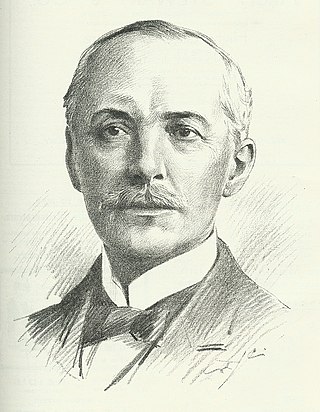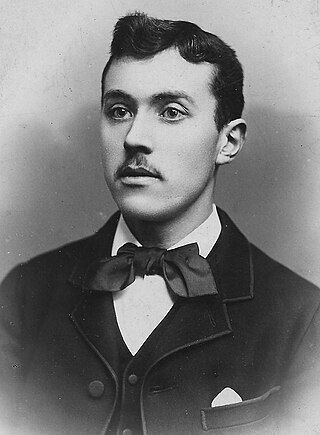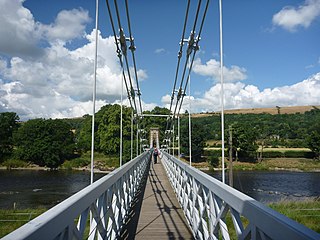
Hawick is a town in the Scottish Borders council area and historic county of Roxburghshire in the east Southern Uplands of Scotland. It is 10 miles (16.1 km) south-west of Jedburgh and 8.9 miles (14.3 km) south-south-east of Selkirk. It is one of the furthest towns from the sea in Scotland, in the heart of Teviotdale, and is the biggest town in Roxburghshire. The town is at the confluence of the Slitrig Water with the River Teviot.

Gatehouse of Fleet is a town, half in the civil parish of Girthon, and half in the parish of Anwoth, divided by the river Fleet, Kirkcudbrightshire, within the council administrative area of Dumfries and Galloway, Scotland.

Sir John James Burnet was a Scottish Edwardian architect who was noted for a number of prominent buildings in Glasgow and London. He was the son of the architect John Burnet, and later went into partnership with his father, joining an architectural firm which would become an influential force in British Modern architecture in the 20th century.

Dunfermline City Chambers is a municipal facility at the corner of Bridge Street and Kirkgate in Dunfermline, Fife. The building, which serves as home to the local area committee of Fife Council, is a Category A listed building.

Coatbridge Library is a public library in Coatbridge, North Lanarkshire, Scotland.

James Hoey Craigie TD FRIBA was a Scottish architect. He studied at the Glasgow School of Art. In 1894 he won the Alexander Thomson travelling scholarship which he spent in France and Italy. In 1905 he was made a partner in the firm Clarke & Bell, its name changing to Clarke & Bell & J H Craigie.

The Chambers Institution is a municipal structure in the High Street in Peebles, Scotland. The structure, which was designed to accommodate a library, a museum, an art gallery and Peebles Burgh Hall, is a Category A listed building.

Gattonside is a small village in the Scottish Borders. It is located 1 kilometre (0.62 mi) north of Melrose, on the north side of the River Tweed. In 1143, the lands of Gattonside were granted to the monks of Melrose Abbey by King David I.

The Soap Factory at 111 Gallowgate, Aberdeen, Scotland, was built for Ogston & Tennant, soap and candle manufacturers, in 1922. The building was designed to be the formal office and to stand detached from the main factory and warehouses, which opened onto Loch Street. Ogston & Tennant ceased trading in the 1970s, and the building is now used as offices. It is a category C listed building.

George Street is the central thoroughfare of the First New Town of Edinburgh, planned in the 18th century by James Craig.
Alexander Lorne Campbell (1871–1944) was a Scottish architect, who practised across Scotland. He was founder of the successful firm of Scott & Campbell.

The Dunfermline Carnegie Library opened in Dunfermline, Scotland, on 29 August 1883 and was the world's first Carnegie Library funded by the Scottish-American businessman and philanthropist Andrew Carnegie. It was designed by Edinburgh architect James Campbell Walker who also designed the nearby Dunfermline City Chambers. Andrew Carnegie donated £8000 to building and stocking what would be the first of over 2,500 Carnegie Libraries. The library was made a Category B listed building in 1971.

West Seaton House is a listed building of late Regency design, situated approximately one mile (1.6 km) to the east of Arbroath in the parish of St. Vigeans, in the county of Angus in Scotland. Prior to 2009 the house was known as West Seaton Farmhouse.

Carnegie Hall is an Art Deco theatre located in Dunfermline, Fife, Scotland. It was named after the industrialist and philanthropist Andrew Carnegie, who was born in Dunfermline. Designed by architects Muirhead and Rutherford, it was officially opened in 1937 and was designated a Category B listed building in 1993.

Coldside Library is a community library operated by Leisure and Culture Dundee. Its opening hours run from Monday to Saturday weekly. It offers book borrowing services, free Wi-Fi and computers for internet access, as well as educational activities for families and adults in the Dundee area. The library was one of five Carnegie libraries commissioned in 1901 for the City of Dundee. The library was designed in 1906 by city architect James Thomson as one of the first two projects undertaken after his appointment to the post in 1904. Coldside library is one of the first free libraries in Dundee and has continued to operate as a public library to this day. Towards the end of the 1940s, Coldside Library also hosted the Dundee studio for BBC Radio Scotland.
Alexander Esmé Gordon was a Scottish Modernist architect, writer, and painter who served as Secretary of the Royal Scottish Academy between 1973 and 1978.

Bo'ness Town Hall is a municipal building in Stewart Avenue, Bo'ness, Scotland. The structure, which was the meeting place of Bo'ness Burgh Council, is a Category B listed building.

R. W. Forsyth, often just called Forsyth's, was a group of department stores founded in Glasgow in 1872. The business expanded into Edinburgh in 1906 and London in 1925.


















